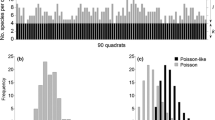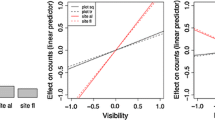Abstract
Cover is the most frequently used measure of abundance in vegetation surveys of grasslands, and various qualitative and semi-quantitative methods have been developed for visual estimation of this metric. Field survey is usually made with a point-grid plate. The frequency distributions of cover derived from point-grid counts follow a beta distribution. Combining point-grid counts from a field survey and the beta distribution for a statistical analysis, we developed an effort-saving cover-measurement method. Cover is measured with a transparent plastic plate on which, for example, 10 × 10 = 100 points are arranged in a lattice with 1-cm grid spacing (thus, one point count represents 1 cm2 of cover). N quadrats are set out at randomly dispersed sites in a grassland, and, in each, the plastic plate is used for making counts. The number of grid points located above a given species is counted in every quadrat until the number of counted points reaches a given value c, which is determined in advance. If the number of counted points reaches c in a quadrat, the count is stopped and the quadrat is classified in the category “>c”. In quadrats where c is not attained, full point counts above the species bodies are made. Let g be the number of observed quadrats whose cover is ≤c. Using these g cover measurements and the number of quadrats (N − g) with cover >c, we can quantitatively estimate cover for each species and the spatial pattern index value based on the maximum likelihood method. In trial counts using this method, the time savings varied between 5% and 41%, depending on the shape of the cover frequency distribution. The mean cover value estimates agreed well with conventional measures without a stopping point (i.e., based on full counts of all points in each quadrat).



Similar content being viewed by others
References
Bonham CD (1989) Measurements for terrestrial vegetation. Wiley, New York, pp 96–126
Bonham CD, Clark DL (2005) Quantification of plant cover estimates. Grassl Sci 51:129–137
Braun-Blanquet J (1965) Plant sociology. Translated from Pflanzensoziologie (German, 1932). Hafner, London, pp 1–439
Chen J, Shiyomi M, Yamamura Y, Hori Y (2006) Distribution model and spatial variation of cover in grassland vegetation. Grassl Sci 52:167–173
Chen J, Shiyomi M, Yamamura Y, Hori Y (2007) Frequency distribution models for spatial patterns of vegetation abundance. Ecol Model (in press)
Curtis JT (1947) The palo verde forest type near Gonaives, Haiti, and its relation to the surrounding vegetation. Caribb For 8:1–26
Daubenmire RF (1959) Canopy coverage method of vegetation analysis. Northwest Sci 33:39–64
Huang D, Liu X, Song B, Chen J, Shiyomi M, Wang Y, Takahashi S, Hori Y, Yamamura Y (2007) Vegetation spatial heterogeneity of different soil regions in Inner Mongolia, China. Tsinghua Sci Technol 12:413–423
Hughes G, Madden LP (1993) Using the beta-binomial distribution to discrete aggregated patterns of disease incidence. Phytopathology 83:759–768
Kawada K, Vork AG, Filatova OV, Akaki M, Nakamura T, Hayashi I (2005) Floristic composition and plant biomass production of steppe communities in the vicinity of Kharkis, Ukraine. Grassl Sci 51:205–213
Kemp CD, Kemp AW (1956) The analysis of point quadrat data. Aust J Bot 4:167–174
Madden LV, Nault LR, Murral DJ, Apelt MR (1995) Spatial pattern analysis of the incidence of aster yellow disease in lattice. Res Popul Ecol 37:279–289
Masuyama M (1964) Statistical methods for small samples. Takeuchi-Shoten, Tokyo, p 139 (in Japanese)
Numata M (1988) Diagnosis of conditions and trends in rangelands. Rangeland resources—management and utilization. Range Management Society of India, New Delhi, pp 116–132
Penfound WT, Howard JA (1940) A phytosociological analysis of evergreen oak forest in the vicinity of New Orleans, Louisiana. Am Midl Nat 23:165–174
Pielou EC (1977) Mathematical ecology. Wiley, New York, pp 236–237
Shiyomi M, Takai A (1979) The spatial pattern of infected or infested plants and negative hypergeometric series. Jpn J Appl Entomol 23:224–229 (in Japanese with English summary)
Shiyomi M, Yoshimura J (2000) Measures of spatial heterogeneity for species occurrence or disease incidence with finite-counts. Ecol Res 15:13–20
Shiyomi M, Takahashi S, Yoshimura J (2000) A measure for spatial heterogeneity of a grassland vegetation based on the beta-binomial distribution. J Veg Sci 11:627–632
Shiyomi M, Gaborcik N, Koizumi H, Javorkova A, Uhliarova E, Jezikova O (2004) Spatial patterns and species diversity of plant communities in sown, oversown, and semi-natural grasslands in Banska Bystrica, Slovakia. Grassl Sci 50:1–8
Tsutsumi M, Shiyomi M, Takahashi S, Sugawara K (2001) Use of beta-binomial series in occurrence counts of plant populations in sown grasslands. Grassl Sci 47:121–127
Wang Y, Shiyomi M, Tsuiki M, Tsutsumi M, Yu X, Yi R (2002) Spatial heterogeneity of vegetation under different grazing intensities in the Northwest Heilongjiang steppe of China. Agric Ecosyst Environ 90:217–230
Wilks SS (1962) Mathematical statistics. Wiley, New York, pp 136–138, 173–175
Zwillinger D, Kokoska S (2000) Standard probability and statistics tables and formulae. Chapman & Hall/CRC, Boca Raton, USA, pp 115–116
Acknowledgments
We are much obliged to acknowledge a suggestion for this study given by an anonymous reviewer.
Author information
Authors and Affiliations
Corresponding author
About this article
Cite this article
Chen, J., Shiyomi, M., Bonham, C.D. et al. Plant cover estimation based on the beta distribution in grassland vegetation. Ecol Res 23, 813–819 (2008). https://doi.org/10.1007/s11284-007-0443-3
Received:
Accepted:
Published:
Issue Date:
DOI: https://doi.org/10.1007/s11284-007-0443-3




